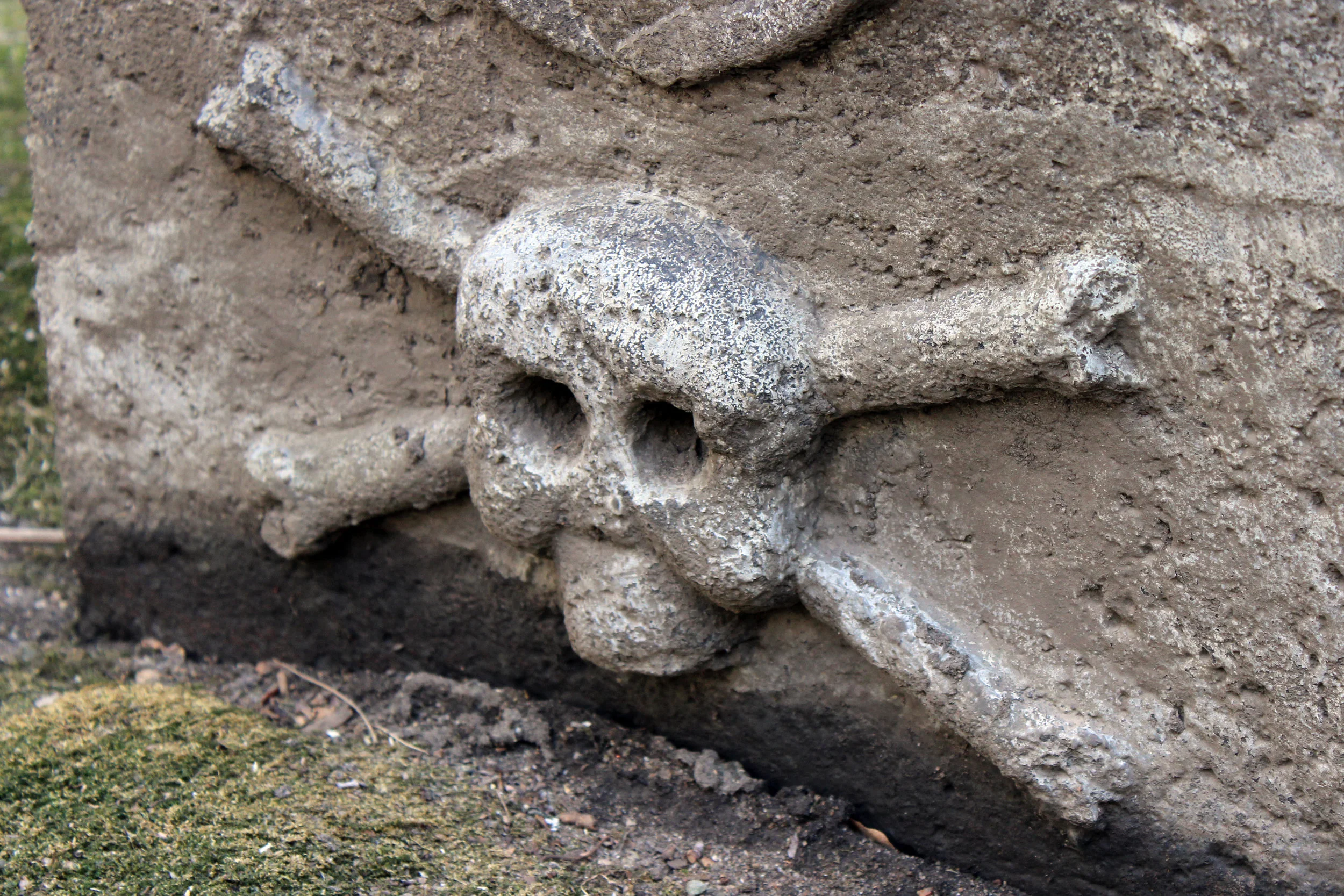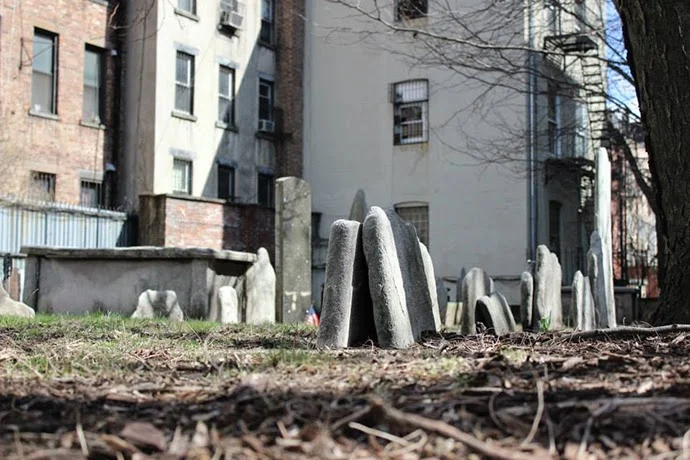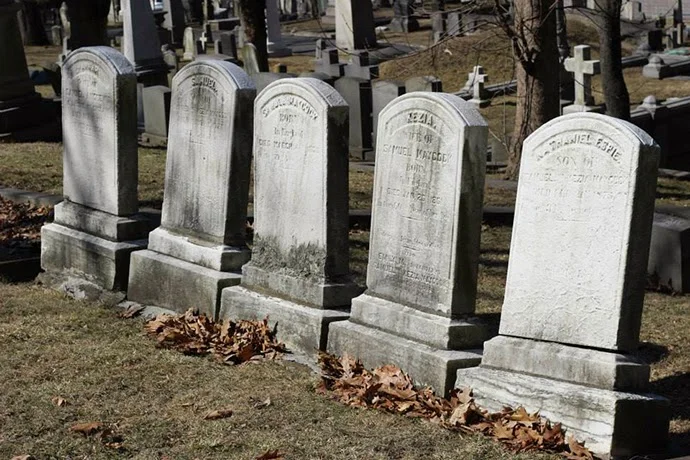Manhattan Cemeteries
A few weeks ago I asked my mom if she wanted to go on a tour with me of some of the cemeteries in lower Manhattan and she replied, “I didn’t know there were any cemeteries in Manhattan.” Many people may know about the oldest cemeteries—or rather, graveyards—associated with Trinity Church near the World Trade Center, but even I didn’t know about all of the burial grounds tucked behind fences and in between buildings until I lived here.
The Cemeteries of the Spanish and Portuguese Synagogue
The Congregation Shearith Israel was America's first Jewish Congregation and was founded in 1654. There are three cemeteries associated with the congregation in Manhattan (a fourth, Beth Olam Cemetery in Ridgewood, has hosted burials for the congregation since 1851). The first is near Chinatown, the second is in Greenwich Village and the third is in Chelsea.
The first cemetery dates back to 1656 and is the first Jewish cemetery in the United States (the Congregation is the oldest in North America). Although the exact location of the original cemetery is not known, it was established at its current location in 1683. Over the years the land has been chiseled away by city expansion and erosion and sadly a lot of the bodies have been disinterred. It's larger than the second, gated (and locked) like the other two, and raised above sidewalk-level so you have to stand on your tip-toes to get a good look.
A special ceremony is held at the cemetery each year on the Sunday before Memorial Day, otherwise the cemetery is closed the public.
55 - 57 St James Place, near Oliver and Madison Streets
The second cemetery was active from 1805-1829 and was used primarily to bury victims of communicable diseases like yellow fever and malaria, as well as for Jews who passed away in New York but were not members of the Congregation. The expansion of the (very desirable) neighborhood has forced many of the remains to be re-interred elsewhere, but a few worn tombstones remain and it is now officially the smallest cemetery in Manhattan.
Closed to the public but it’s so small the entire cemetery can be seen from the sidewalk.
72 W 11th Street, near Sixth Avenue
The third cemetery was in use from 1829-1851 and it’s currently located right across the street from a Trader Joe’s. It appears to be the largest of the three cemeteries, and is in the best condition (a plaque on the fence mentions a recent restoration). However, a lot of the stones are worn to the point of being unreadable from the street.
Closed to the public, but mostly visible from the sidewalk.
W 21st Street, near Sixth Avenue
Trinity Church
The original graveyard at Trinity Church in lower Manhattan, opened in 1697 and is one of three separate burial grounds associated with the church. The other two are located at the nearby St. Paul's Chapel and uptown at Trinity Church Cemetery and Mausoleum. This is probably the best place for finding classic skull and winged cherub stones in all five boroughs and most of the stones are remarkably well-preserved. Trinity’s most famous resident is Alexander Hamilton, but my favorite epitaph belongs to David Ogden, "who on the 27th of September 1798 in the 29th year of his age fell a victim to the prevailing epidemic."
Tours of Trinity churchyard are available by request, weather permitting, but self-guided tours are allowed during normal hours—just stay on the paths and be respectful of the historic stones.
Trinity Church: 75 Broadway, between Rector and Liberty Streets
St. Paul’s Chapel: 209 Broadway, between Vesey and Fulton Streets
Trinity Church Cemetery and Mausoleum is the only active cemetery remaining on the island of Manhattan. It’s located between West 153rd and 155th streets with Broadway splitting the grounds into two sections. The west section is set on a hill with beautiful views of the Hudson River and the George Washington Bridge. This is the final resting place of the Astors, Ralph Waldo Ellison, John James Audubon and—more recently—Law & Order’s Jerry Orbach and former New York Mayor Ed Koch.
Gates are open 9am-4pm. The entrance to the east side of the cemetery is on 155th street.
Entrance to the west side is at 70 Riverside Drive, between W 153rd and W 155th Streets.
More than 15,000 enslaved and free Africans were buried here during the late 17th and 18th centuries. 419 skeletons were found in the ‘90s during construction of a federal building and in 1993 the site became the first underground New York City and national historic landmark. New York had the second-largest number of enslaved Africans in the nation after Charleston, South Carolina, and this site was designated as a National Monument in 2006. Although it doesn’t look like a traditional cemetery, in 2007, a memorial was dedicated and a visitor center opened in 2010.
Open 10am-4pm, Saturday-Friday.
290 Broadway, New York, NY 10007
Most of the headstones and catacomb interments date from the 1800s at Old St. Patrick’s Cathedral. The catacombs aren't like the bone-filled niches of Europe, but more like the ones at Green-Wood Cemetery—underground tunnels lined with hermetically sealed crypts and marked with carved stones. There are 35 family crypts and five clerical vaults, in addition to newly-built columbaria.
Notable interments include: members of the Delmonico family, founders of Delmonico's, the first American restaurant to allow patrons to order from a menu; Countess Annie Leary, one of the only Catholics to be included in Mrs. Astor's "The 400," a list of fashionable socialites; and Tammany Hall boss and Congressman "Honest John" Kelly.
Access to the cemetery and catacombs is available only by taking a tour with Tommy’s New York.
263 Mulberry Street, between Houston and Prince Streets
Founded in 1830, the oldest public non-sectarian cemetery in New York City—not to be confused with the nearby New York City Marble Cemetery—is open at least one day a month during warmer months. The grounds are hidden away down a little alleyway and marked by an arched gate. There are no traditional headstones here—instead, there are 156 below-ground burial vaults with the names of the interred carved in plaques embedded in the surrounding stone wall.
Underground vaults were popular at the time due to health concerns over the burials of people who had suffered from infectious diseases like tuberculosis. The New York Marble Cemetery is available to rent out for parties and weddings (get married and buried!) and still hosts the occasional burial—if your family vault still has space and you have proof of relation.
Open select weekends April-October.
41 1/2 2nd Avenue, between E 2nd and E 3rd Streets
Just one block east is the New York City Marble Cemetery, established in 1831. The grounds are studded with headstones like a traditional cemetery, along with underground vaults designated with flat, marble markers. It also has a fantastic iron fence and gate, with a wonderful tombstone-shaped sign with arching letters. It's not as secluded as the New York Marble Cemetery, but it's a great place to spend the afternoon and have a picnic amongst hundreds of circa-1800s graves.
Open select weekends May-October.
52-74 E 2nd Street, between Second and First Avenues
💀 It’s Día de Muertos! Celebrate by browsing my cemetery posts here 💀






































